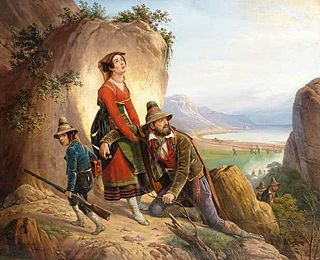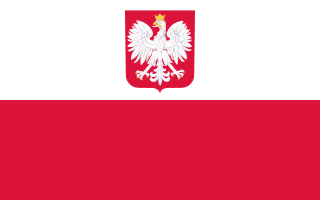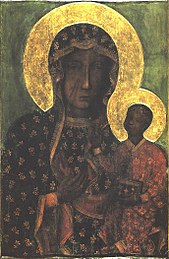
The history of Poland spans over a thousand years, from medieval tribes, Christianization and monarchy; through Poland's Golden Age, expansionism and becoming one of the largest European powers; to its collapse and partitions, two world wars, communism, and the restoration of democracy.

Adam Bernard Mickiewicz was a Polish poet, dramatist, essayist, publicist, translator and political activist. He is regarded as national poet in Poland, Lithuania and Belarus. A principal figure in Polish Romanticism, he is one of Poland's "Three Bards" and is widely regarded as Poland's greatest poet. He is also considered one of the greatest Slavic and European poets and has been dubbed a "Slavic bard". A leading Romantic dramatist, he has been compared in Poland and Europe to Byron and Goethe.

From 1795 to 1918, Poland was split between Prussia, the Habsburg monarchy, and Russia and had no independent existence. In 1795 the third and the last of the three 18th-century partitions of Poland ended the existence of the Polish–Lithuanian Commonwealth. Nevertheless, events both within and outside the Polish lands kept hopes for restoration of Polish independence alive throughout the 19th century. Poland's geopolitical location on the Northern European Lowlands became especially important in a period when its expansionist neighbors, the Kingdom of Prussia and Imperial Russia, involved themselves intensely in European rivalries and alliances as modern nation-states took form over the entire continent.

Roman Stanisław Dmowski was a Polish politician, statesman, and co-founder and chief ideologue of the National Democracy political movement. He saw the Germanization of Polish territories controlled by the German Empire as the major threat to Polish culture and therefore advocated a degree of accommodation with another power that had partitioned Poland, the Russian Empire. He favoured the re-establishment of Polish independence by nonviolent means and supported policies favourable to the Polish middle class. While in Paris during World War I, he was a prominent spokesman for Polish aspirations to the Allies through his Polish National Committee. He was an instrumental figure in the postwar restoration of Poland's independent existence. Throughout most of his life, he was the chief ideological opponent of the Polish military and political leader Józef Piłsudski and of the latter's vision of Poland as a multinational federation against German and Russian imperialism.

The Silesian Uprisings were a series of three uprisings from August 1919 to July 1921 in Upper Silesia, which was part of the Weimar Republic at the time. Ethnic Polish and Polish-Silesian insurrectionists, seeking to have the area transferred to the newly founded Polish Republic, fought German police and paramilitary forces which sought to keep the area part of the new German state founded after World War I. Following the conflict, the area was divided between the two countries. The rebellions have subsequently been commemorated in modern Poland as an example of Polish nationalism. Despite central government involvement in the conflict, Polish historiography renders the events as uprisings reflecting the will of ordinary Upper Silesians rather than a war.
Slavophilia was a movement originating from the 19th century that wanted the Russian Empire to be developed on the basis of values and institutions derived from Russia's early history. Slavophiles opposed the influences of Western Europe in Russia. Depending on the historical context, the opposite of Slavophilia could be seen as Slavophobia or also what some Russian intellectuals called zapadnichestvo (westernism).

Dziady is a poetic drama by the Polish poet Adam Mickiewicz. It is considered one of the greatest works of both Polish and European Romanticism. To George Sand and Georg Brandes, Dziady was a supreme realization of Romantic drama theory, to be ranked with such works as Goethe's Faust and Byron's Manfred.

Western Krai was an unofficial name for the westernmost parts of the Russian Empire, excluding the territory of Congress Poland. The term encompasses the lands annexed by the Russian Empire in the successive partitions of the Polish–Lithuanian Commonwealth in the late 18th century – in 1772, 1793, 1795 and located east of Congress Poland. This area is known in Poland as Ziemie Zabrane but is most often referred to in Polish historiography and common parlance as part of Zabór Rosyjski. Together with Bessarabia and the former Crimean Khanate, the territory roughly overlapped also with the Jewish Pale of Settlement of the Russian Empire, and included much of what is today Belarus, Ukraine, and Lithuania.

There were many resistance movements in partitioned Poland between 1795 and 1918. Although some of the szlachta was reconciled to the end of the Polish–Lithuanian Commonwealth in 1795, the possibility of Polish independence was kept alive by events within and without Poland throughout the 19th century. Poland's location on the North European Plain became especially significant in a period when its neighbours, the Kingdom of Prussia and Russia were intensely involved in European rivalries and alliances and modern nation states took form over the entire continent.

Polish nationalism is a form of nationalism which asserts that the Poles are a nation and promotes the cultural unity of Poles. Norman Davies, in the context of Polish nationalism, generally defined nationalism as "a doctrine ... to create a nation by arousing people's awareness of their nationality, and to mobilize their feelings into a vehicle for political action".

Polish–French relations are relations between the nations of France and Poland, which date back several centuries.

The history of Ukrainian nationality can be traced back to the kingdom of Kievan Rus' of the 9th to 12th centuries. It was the predecessor state to what would eventually become the Eastern Slavic nations of Belarus, Russia, and Ukraine. During this time, Eastern Orthodoxy, a defining feature of Ukrainian nationalism, was incorporated into everyday life.

Like in other nations across the world, there are several far-right organizations and parties operating in Poland.

Austria–Poland relations are foreign relations between Austria and Poland. The two nations have a very long historical relationship dating back several centuries, which has been complicated throughout most of their history.

The Germanisation of the Province of Posen was a policy of the Kulturkampf measures enacted by German Chancellor Otto von Bismarck, whose goal was to Germanize Polish-speaking areas in the Prussian Province of Posen by eradicating and discrimination of Polish language and culture, as well as to reduce the influence of the "ultramontanist" Roman Catholic clergy in those regions.

The Polish-Lithuanian identity describes individuals and groups with histories in the Polish–Lithuanian Commonwealth or with close connections to its culture. This federation, formally established by the 1569 Union of Lublin between the Kingdom of Poland and Grand Duchy of Lithuania, created a multi-ethnic and multi-confessional state founded on the binding powers of national identity and shared culture rather than ethnicity or religious affiliation. The term Polish-Lithuanian has been used to describe various groups residing in the Commonwealth, including those that did not share the Polish or Lithuanian ethnicity nor their predominant Roman Catholic faith.
The Antemurale myth or the Bulwark myth is one of the nationalist myths which implies a certain nation's mission of being a bulwark against the other religions, nations or ideologies. The word "Antemurale" is derived from Latin ante and murale.

A Polonophile is an individual who respects and is fond of Poland's culture as well as Polish history, traditions and customs. The term defining this kind of attitude is Polonophilia. The antonym and opposite of Polonophilia is Polonophobia.
Liberalism has been a notable ideology in Poland for hundreds of years. Polish liberalism emphasizes the preservation of democracy and opposition to authoritarianism. Liberalism was first developed in Poland as a response to the Polish–Lithuanian monarchy, and it continued to develop in response to the partition of Poland through the 19th century and Communist rule in the 20th century. Poland has officially been a liberal democracy since 1989, though its status has challenged as a result of illiberal reforms in the 2010s and 2020s.
This is a select bibliography of English language books and journal articles about the history of Poland. A brief selection of English translations of primary sources is included. Book entries have references to journal articles and reviews about them when helpful. Additional bibliographies can be found in many of the book-length works listed below; see Further Reading for several book and chapter-length bibliographies. The External Links section contains entries for publicly available select bibliographies from universities and national libraries. This bibliography specifically excludes non-history related works and self-published books.

















